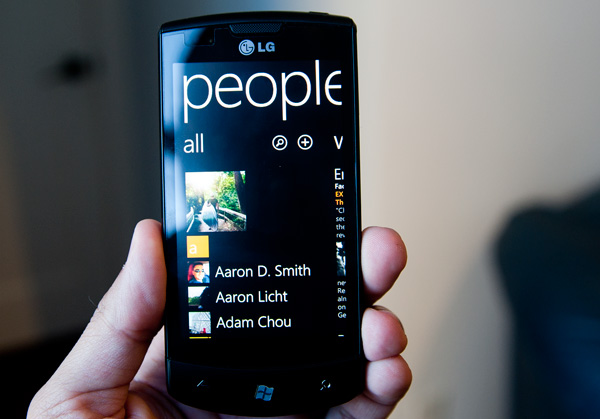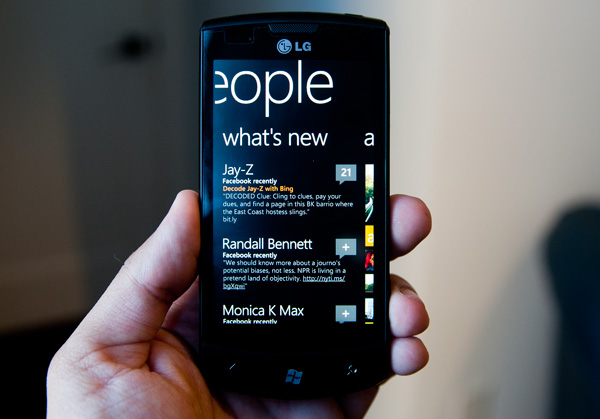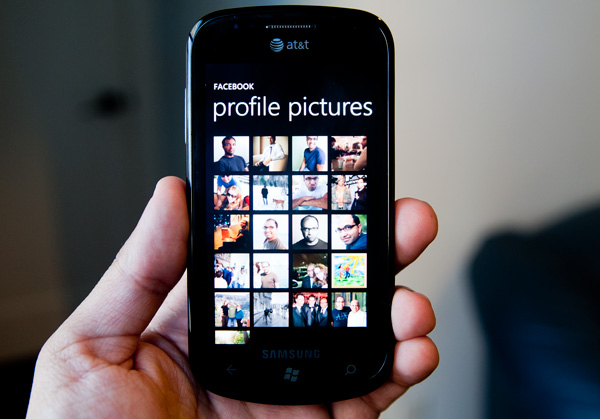The Windows Phone 7 Review
by Anand Lal Shimpi & Brian Klug on October 20, 2010 7:00 PM EST- Posted in
- Smartphones
- Windows Phone 7
- Microsoft
- Mobile
Facebook Integration
Windows Phone does the best job of Facebook integration I’ve seen of any smartphone platform.
Palm’s webOS was the first to seamlessly integrate Facebook into a modern day smartphone. Supply it with your Facebook credentials and you saw the entirety of your oversized friends list appear in your phone contacts. Email addresses, IM accounts, phone numbers and more were all automatically populated in your address book. If any of your Facebook friends changed their information, the information updated on its own on your phone. It was the wave of the future.
Spiritually, Microsoft picks up where Palm left off. You can do the same sort of blanket integration that you could with the Pre. Supply your Facebook login information and Microsoft syncs all of your contacts through the cloud. Unlike webOS however, Microsoft gives you an option to not sync all of your Facebook friends. You can choose to only sync those Facebook contacts who are already in your address book (from Google, Hotmail, Exchange or Yahoo).
Microsoft integrates Facebook in more places than just your address book however. Meet the People Hub.
People Hub
For all intents and purposes the People hub is the Facebook app for Windows Phone 7. If you’ve supplied your Facebook login, the default “what’s new” tab will serve as your news feed. It’s not the reduced load Top News feed you get from Facebook, but literally the most recent news from all of your Facebook friends and pages. You get 25 posts by default (non customizable) and there’s a get older posts button at the bottom of the page if you want to see more.
It’s not a total Facebook app replacement as you don’t get non-content updates. Items like who your friends have added to their friends list are absent from the feed. There is also no integration of friend request management. The Facebook integration is mostly for passive consumption with a couple of exceptions. You can view and add comments to posts as well as like posts, however you can’t see who has liked a post (just the number of likes for any given post).
Tapping on anyones name in the what’s new feed brings you to their contact page. You can view their “what’s new” feed and comment on their posts. You can also view their profile which will pull in data from both Facebook and your contacts (e.g. through Google or Live). Microsoft clearly (and cleanly) indicates what sources it is using to pull the profile information from under the contact’s name.
If you really like talking to/keeping tabs on/being creepy to a person, you can pin their profile to your Start screen for easy access.
From the profile tab you can write on their Facebook wall, send an email, make a phone call, send them a text message or even bring up their address on Bing maps.
All of these functions are super fast and seamlessly integrated into the experience. Quickly writing on someone’s wall without having to fire up a separate Facebook app couldn’t be faster. There’s literally a Write on wall screen that quickly appears when you select the option to. Sending an email or text message from the profile screen is a bit slower since you’re technically switching to another app, but it’s near instantaneous.
Here’s where the functionality of the back button really one-ups iOS multitasking. Let’s say I’m viewing a friend’s profile and I want to get directions to his house. I can click on his address on the profile page which will immediately fire up the Maps app. I can use Maps to quickly see where he lives (or eventually get directions) but now when I want to go back to his profile to send him a text message, there’s no double tapping or app selection - I just hit the back button and I’m back at his profile. Had I tried to get directions while at the Maps screen I would’ve tapped the back button twice (once to get out of directions and into the normal map and once again to go back to the profile) but it’s still a snappier process than manually switching between apps in iOS. The advantage is really limited to these types of scenarios however.
There’s still the need for a standalone Facebook app for more of the FB-specific features (gift giving, messaging, apps, chat, etc...), but the People hub gives you access to the most commonly used tasks. Update: A standalone Facebook app is now available for WP7.
While you can exclude Facebook friends who aren’t already in your address book from appearing in your address book, doing so will not keep those friends from appearing in your what’s new feed. The good news is that the what’s new feed will respect your Facebook news feed options. If you’ve removed someone’s updates from appearing in your Facebook news feed, their updates won’t appear in the what’s new tab on Windows Phone 7.
Today Facebook is front and center with Windows Phone, but it would be just as easy for Microsoft to extend the interface to support other social networks or status aggregators. Twitter obviously comes to mind and while Microsoft isn’t officially announcing anything yet, that’s clearly a target that we can expect to see pulled in at some point.
Aside from the news feed, there are two more tabs to the People hub: recent and all. The recent tab is actually a two-page tab that displays up to 8 tiles of people you’ve either recently communicated with or whose profiles you’ve viewed/stalked. The tiles are animated so you’ll see them alternate between a photo, photo + name, or just name.
This tab is effectively your favorites as there is no such functionality in the Phone app. You don’t get one touch dialing or emailing unfortunately, you’ll need one tap to select the contact and one more to choose your communication method.
The all tab is exactly what it sounds like - a list of all of your contacts. The topmost contact? A big link to your own profile of course, which you can use to provide status updates on your Facebook wall.
The search button will let you search through the all people tab. Results are narrowed down/highlighted as you type.
Tapping on any of the highlighted headers brings you to this screen, which you can use to jump to any other header in the list. I feel like the Android/iOS scrolling widget makes more sense but the Microsoft approach does work.
Facebook Photo Integration
What I was more impressed by was the Facebook integration in the Pictures hub. Your profile pictures and mobile uploads are both listed as albums when looking through all of your photos by date. Browsing photos you’ve synced, photos you’ve stored in the cloud and photos you’ve uploaded to Facebook is not only possible, but done sensibly. On top of all of that, there’s also a what’s new tab in the Pictures hub that just gives you a feed of all of the photos your Facebook friends have posted recently. It’s a great way to photo stalk if that’s what you ultimately end up doing on Facebook anyway.
While Palm used Facebook as a way to integrate contacts, other companies have since tried to pull status updates and photos from the service to populate your phone. Microsoft now joins the list of those who have tried, and while the integration isn’t perfect, it’s quite possibly the best attempt yet.














125 Comments
View All Comments
soaringrocks - Thursday, October 21, 2010 - link
I find it amusing that for a 'phone' there is often little to no discussion on call quality, reception, and ability to maintain connection in a difficult environment. We know that all phones are not equal on that score...It's like you don't expect people to actually make phone calls.
beefnot - Thursday, October 21, 2010 - link
Making phone calls with your smart phone is just so passe.strikeback03 - Friday, October 22, 2010 - link
They said they have reviews of the actual phones coming, that is the type of info that would be in a review of the phone, not the OS.thartist - Thursday, October 21, 2010 - link
sick amount of quality work. the only WP7 review on the web so far as it had to be done.Anand, keep that quality work that puts you so above from the rest.
softdrinkviking - Thursday, October 21, 2010 - link
The lack of "change on the fly" micro SD is a deal killer for me.It's a shame too, because I really like everything else about this phone.
Smilin - Monday, October 25, 2010 - link
Curious: Why do you need such a feature?softdrinkviking - Friday, November 5, 2010 - link
whoa, i don't know if anyone else, or even you will get back to reading this but...i use SD cards to store music on. i have a situation where i can't always sync with my home pc very often, and i can't always carry around a laptop, so bringing along a handful of different SD cards with a variety of tunes has been important to me.
what i'd really like is for card-swapping to get more convenient, like in cameras.
btdvox - Thursday, October 21, 2010 - link
In your review you guys say the LG Optimus 7 has a MicroSD slot that we can expand on, yet nowhere else does it say that on the web. Can you verify this? If it does than this phone is a clear winner for me, It's also avail in Canada btw. I'd hope we're just as important as Asia and Europse but I suppose were not haha.softdrinkviking - Friday, October 22, 2010 - link
the trick is that the microSD card gets treated like part of the built-in memory, and you cannot replace it without completely erasing your phone and starting over.so you basically have to choose a single SD card and stick with it, there is no changing on the fly like in android phones.
btdvox - Friday, October 22, 2010 - link
Wasnt really my question but thanks.But still unanswered is, I dont think LG Optimus 7 has a microsd slot, Engadget just reviewed it and stated it doesnt have a memory slot. Can you guys confirm this?